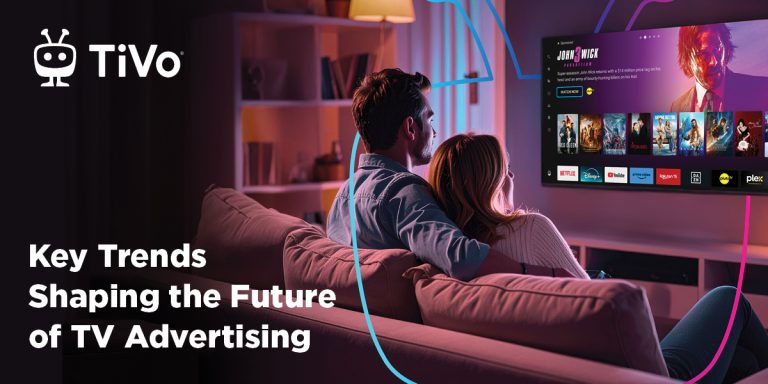We’re entering a new chapter in connected TV and streaming where viewers are no longer just consumers — they’re curators of their own experiences. The TiVo Q4 2024 Video Trends Report offers a fresh look at what today’s audiences want: more control, less clutter and better ways to discover and engage with content.
What emerges from the data isn’t just a list of preferences — it’s a roadmap for advertisers and platforms. From how ads are delivered to where discovery happens, the viewing experience is evolving quickly. In this blog, we unpack four distinct trends shaping the way forward: smarter upfront advertising, the strategic role of the home screen and the nuanced future of interactive ads.
Trend 1: The rise of upfront ads
As streaming matures, so too do viewer expectations around advertising. The TiVo Q4 2024 Video Trends Report reveals a growing preference for upfront ads, with 67% of viewers saying they’d rather see all ads at the start of a show than have them disrupt their viewing.
This shift reflects more than just impatience with interruptions — it’s a clear ask for control and immersion. Giving viewers an ad-free experience once the program starts not only respects their attention but offers advertisers a more focused, intentional window for brand storytelling.
Personalization is where upfront ads can evolve, with 42% of respondents favoring personalized ads, 41% preferring to choose which ad to watch and 43% wanting to customize ad categories. For advertisers, the opportunity here isn’t just to show up early — it’s to show up smart, with tailored messaging that aligns with both the format and the moment.
Trend 2: Ad tolerance is up — but expectations are higher
Forget the narrative that “no one wants ads.” A striking 76% of consumers now say they are comfortable with advertising, as long as it’s relevant and non-repetitive. This is helping fuel the rise of ad-supported streaming.
What’s driving that comfort? Lower ad loads on streaming services like Netflix and Peacock, plus improved targeting. Viewers want fewer, better ads — ones tailored to their preferences and viewing habits.
Additionally, sports content continues to be a major driver of acquisition and retention, with services like Netflix and Tubi experimenting with event-based access. The ad opportunity around sports and live events is enormous — and platforms that nail aggregation and promotion will win the battle for attention.
Trend 3: The power of the home screen
The TV home screen has become the new front door to the viewing experience — and increasingly, a critical advertising surface. A substantial 70% of smart TV owners have noticed information about TV shows or movies on their home screens. This high visibility creates a prime opportunity for advertisers to capture viewer attention at the very start of their viewing journey.
What’s even more compelling is the potential for personalized home screen advertising. The report shows that 57% of viewers would be more receptive to home screen ads if they were tailored to their viewing habits. This aligns with the broader trend of viewers seeking more relevant and engaging ad experiences. The report also highlights the difference in engagement between pay TV subscribers and broadband-only viewers. A notable 71% of pay TV subscribers regularly use home screens to start watching content, compared to 52% of broadband-only viewers. This gap points to the benefits of aggregation — viewers familiar with consolidated interfaces are quicker to act and more open to content suggestions. For advertisers, this makes the home screen a prime real estate for both branding and discovery — but only if content relevance is dialed in.
Trend 4: The evolving landscape of interactive advertising
QR codes have played a prominent role in bridging screens, but the latest data points to a generational shift. While 25% of viewers say they’ve scanned a QR code from a TV show or ad, Gen Z engagement is down nearly 7%, suggesting a softening of interest among younger, mobile-native audiences.
That doesn’t mean QR codes are obsolete. In fact, usage remains strong among high-income households, who engage with them far more than lower-income groups. But it does signal that QR effectiveness depends heavily on who you’re trying to reach. The takeaway: Interactive tactics must be more targeted. A blanket approach won’t cut it.
More broadly, the report shows that interactive advertising is evolving well beyond the QR format. 23% of respondents have tapped on an interactive commercial on their smartphone or tablet, and 15% have tried interactive game elements or demos within video game ads. These ad formats offer brands more dynamic ways to invite participation — especially when aligned with device behaviors and context. As the ecosystem matures, success will hinge on matching the right experience to the right audience, rather than relying on novelty alone.
Turning insights into impact
The underlying thread across all four trends is clear: viewers want more control, more relevance and less friction. Whether it’s skipping interruptions, navigating from a smart home screen or engaging with interactive ads on their terms, today’s audiences are curating how — and when — they connect with content and brands.
For advertisers, that’s not a challenge — it’s a roadmap. Leaning into personalized upfronts, intent-driven discovery and context-aware interactivity will define the next generation of successful campaigns.
Download the free TiVo Q4 2024 Video Trends Report for more consumer data and video trends.


Comments are closed.